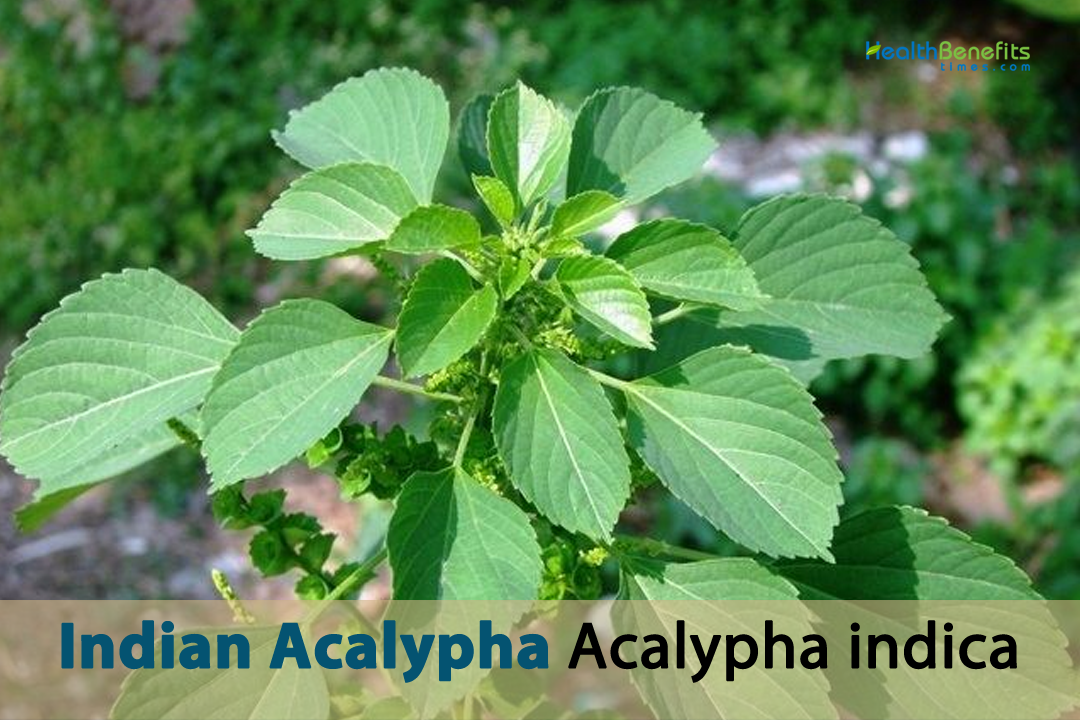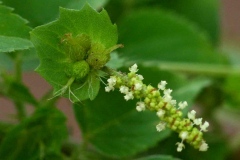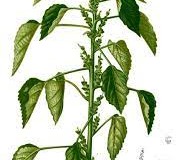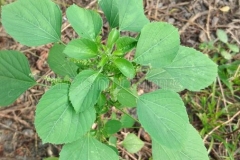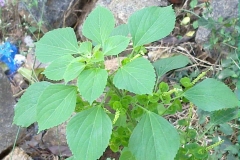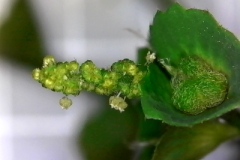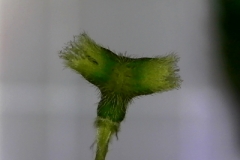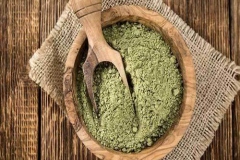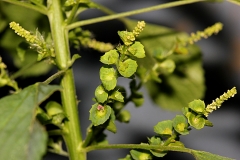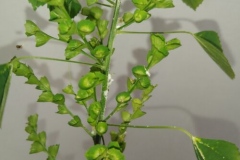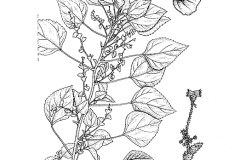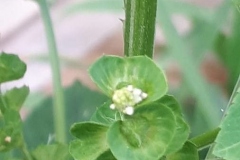| Indian Acalypha Quick Facts | |
|---|---|
| Name: | Indian Acalypha |
| Scientific Name: | Acalypha indica |
| Origin | Eastern and Southern Africa, the Arabian Peninsula, India and South East Asia |
| Colors | Green to brownish-red as they age |
| Shapes | Deeply trilobed globose capsule, 1.5 mm in diameter, hispid, containing three seeds |
| Taste | Slightly bitter taste |
| Health benefits | Anti-inflammatory properties, Antioxidant properties, Anti-diabetic properties, Antibacterial properties, Anti-microbial properties, Digestive health, Wound healing, Treatment of respiratory disorders, Menstrual benefits, Anti-Venom Properties, Treats Scabies, Good for Headache, Treats Ringworm, Treats Arthritis, Used to Remove Facial Hair, Good for Heat Boils, Beneficial for Muscular Pain, Treats Cold & Cough, Treats Dandruff, Treats Bedsores, Good for Pneumonia & Bronchitis, Treat Constipation, Used for Intestinal Worms, Good for Centipede Bite, Used to Treat Acne, Heal Wounds, Treat Nervous Disorders |
| Name | Indian Acalypha or Indian Mercury |
|---|---|
| Scientific Name | Acalypha indica |
| Native | Eastern and Southern Africa, the Arabian Peninsula, India and South East Asia. This species has been introduced in the islands of the Indian Ocean (Madagascar, Comoros, Reunion, Mauritius, Mayotte, Seychelles), as well as in some Central American countries (Mexico, Puerto Rico, Cuba) and in Samoa and rare in eastern Malesia |
| Common Names | Indian nettle, Indian copperleaf, three-seeded mercury, Indian acalypha, Indian mercury, Copperleaf, Poiret’s copperleaf |
| Name in Other Languages | Assamese: Muktojhuri, Patra-manjori, kuppi (কুপ্পি), muktajhurai (মুক্তাঝুৰি), mukuta manjari (মুকুতা-মঞ্জৰী), patrasaki (পত্ৰচাকি), sbeta-basanta (শ্বেত বসন্ত) Bengali: Kupi-lata, Kuppi, Muktajhuri (মুক্তাঝুরি), Sveta-basanta, sbeta basanta (শ্বেত বসন্ত) Burmese: Kyaung ro say pain (ကြောင်ရိုသေပင်) Chamorro: Hierba del cancer Chinese: Tie xian, re dai tie xian cai (热带铁苋菜), Yìndù tiě xiàn (印度铁苋) Dutch: Indisch netelkruid Divehi: Ffufulhi (ވަށްފުފުޅި) English: Indian Acalypha, Indian copperleaf, Indian-nettle, Copperleaf, Three-seeded-mercury, Poiret’s copperleaf French: Herbe chatte, Acalypha, acalypha de l’Inde, ricinelle, safran de la Guadeloupe, Ricinelle des Indes, Oreille de chatte, Herba chatte German: Brennkraut, Indisches Kupferblatt, indisches Brennkraut, Gujarati: Kuphi, Kupadi, vanchi kanto, Dadano, dadaro (દાદરો), haritamanjari (હરીતમંજરી), venchikanto (વેંછીકાંટો) Hindi: Khokali (खोकली), Kuppi, Khorpatthar , Kuppikhokli, Kuppu, Kuppi (कुप्पी), kuppikhokhali (कुप्पीखोखली) Indonesian: Kucing galak, Lelating, Kucing-kucingan, Rumput kokosongan, Rumput bolong-bolong Irula: Kuppagida Italian: Acalifa, ricinella Japanese: Kidachiamigasa (キダチアミガサ) Javanese: Kucing galak (tetuwuhan) Kachchhi: Dadar jo jhad (દદર જો ઝાડ) Kannada: Kuppi gida (ಕುಪ್ಪಿಗಿಡ), Kuppi soppu, Chalmari, Kuppi (ಕುಪ್ಪಿ), jalamali (ಜಲಮಲಿ) Konkani: Kunkmiphala (ಕುಂಕ್ಮಿಫಲ) Malay: Pokok Kucing Galak Malayalam: Kuppamani, Kuppameni (കുപ്പമേനി), Kuppamanian Malaysia: Chika emas, Galak Kuching Manipuri: Khorbaan Marathi: Kuppi (कुपी), Harita Manjari, khokhali (खोखली), kupi (कुपी) Niuean: Hongohongo, ogoogo, ongoongo Oriya: ଇନ୍ଦ୍ରମାରିସ, ଇନ୍ଦ୍ରମାରିଷ indramarisha Persian: آکالیفا هندی Philippines: Bugos, maraotong, taptapingar Portuguese: Urtiga-da-Índia Punjabi: Ban Amli Rajasthani: Khokali (खोकली) Russian: Akalifa indiyskaya (Акалифа индийская), indiyskaya krapiva (индийская крапива) Sanskrit: Haritamanjari (हरित मञ्जरी) Sinhalese: Kuppamēniya (කුප්පමේනිය) Spanish: Hierba de cancer, Ricinela Telugu: Kuppi-aku, Kuppi-jada, Kuppinta, Kuppichedi, Kuppi-Aku, Muripiṇḍi (మురిపిండి), harita-manjari (హరితమంజరి), kuppi (కుప్పి), haritha manjari (హరిత మంజరి), kupintaku (కుప్పింటాకు), kuppi chettu (కుప్పి చెట్టు), muripinda (మురిపిండ), murkonda chettu (మురుకొండ చెట్టు), పిప్పింట pippinta (పిప్పింట) Tamil: Kuppichetti, Kuppi , Kuppaimeni (குப்பைமேனி), Kuppichedi, Kuppivaeni, Kuppichettu, Harita-manjiri, Kuppinta, Muripindi, Naaikurungu, Naai Kurungu, Poonamayakki, koli-p-puntu (கொழிப்பூண்டு), kuppai-meni (குப்பைமேனி), akkini-c-civam (அக்கினிச்சிவம்), anantai (அனந்தை), ankuram (அங்குரம்), antakam (அண்டகம்), Arimañcari (அரிமஞ்சரி) ari-manjari, cakkara-putpi (சக்கரபுட்பி), eri-cikai (எரிசிகை), koli-p-puntu (கொழிப்பூண்டு), kuppai-meni (குப்பைமேனி), mayilam (மயிலம்), murai-mayakki (முறைமயக்கி), naciyari (நசியரி), otu-v-atakki (ஒடுவடக்கி), punai-muli (பூனைமூலி), punai-vananki (பூனைவணங்கி), tiripurattan (திரிபுரத்தான்), tiru-meni (திருமேனி), vimali (விமலி) Thai: Kạỵchā mæw (กัญชาแมว), tamyae tuaphuu, tamyae maeo, haan maeo Tulu: Bangaarakaayi (ಬಂಗಾರಕಾಯಿ), kuppi dai (ಕುಪ್ಪಿ ದೈ) Urdu: Khokli, Khorpatthar Vietnamese: Tai tượng Ấn, tai tượng xanh |
| Plant Growth Habit | Erect, fast growing, annual or sometimes short-lived perennial herbaceous plant |
| Growing Climates | Found in waste areas, thickets, fields, roadsides, backyards, bushes, crevices in walls, rocky hillsides, forest edges, river banks, seasonal water courses and pans, rocky outcrops, disturbed ground and other places |
| Soil | Prefers well-draining soils that are rich in organic matter. It can grow in a range of soil types, including sandy, loamy, and clay soils. However, the soil should be moist but not waterlogged, as this can lead to root rot |
| Plant Size | Usually grows up to 1.5 meters tall with occasional specimens to 2.5 meters |
| Root | Vertical and branched; 2–8 mm in thickness, tortuous, rough; color varies from grey to brown when dry, broken surface creamy yellow |
| Stem | Brownish when mature and younger parts are green, sparsely hairy, terete, 2–10 mm in thickness |
| Leaf | Leaves of the plant are arranged alternately and have a toothed margin. The leaves can be either oval or lance-shaped, depending on the variety |
| Flower | Flowers are small and insignificant, and they appear in spikes that grow from the base of the leaves |
| Fruit Shape & Size | Deeply trilobed globose capsule, 1.5 mm in diameter, hispid, containing three seeds |
| Fruit Color | Green to brownish-red as they age |
| Seeds | Oval to ellipsoidal 1.3 mm long. Smooth seed coat, dark green to black in color |
| Flavor/Aroma | Slightly sweet and pungent scent, which is often described as earthy and herbal |
| Taste | Slightly bitter taste |
| Plant Parts Used | Leaves, roots, stems and whole plant |
| Propagation | By stem cuttings, seed propagation, and division |
| Lifespan | 3-5 years. However, with proper care and maintenance, the plant can live for even longer, up to 7-10 years or more. |
| Varieties | 1. Acalypha Indica 2. Acalypha Wilkesiana 3. Acalypha Hispida 4. Acalypha Godseffiana 5. Acalypha Pendula |
| Health Benefits |
|
Plant Description
Indian Acalypha, which is also called Indian Mercury, is a fast-growing, upright grass plant that can grow up to 1.5 meters tall, though some grow up to 2.5 meters. It grows in waste areas, thickets, fields, along roadsides, in backyards, bushes, cracks in walls, rocky hillsides, forest edges, river banks, seasonal water courses and pans, rocky outcrops, disturbed ground, and other similar places. This plant grows best in soils that drain well and have a lot of organic matter. It can also grow in sandy, loamy, and clay soils. But it’s important to make sure the dirt is damp but not soggy, because that can cause root rot.
Roots
Indian Acalypha is a plant that comes back every year. It has a taproot system, which means that its main root grows straight down into the ground. This taproot can grow quite deep into the dirt, giving the plant access to nutrients and water that other plants may not be able to reach. Most Indian Acalypha roots are brown and have a woody feel to them.
Leaves
The leaves of this plant are simple, meaning they have a single blade, and they are grouped alternately along the stem. The shape of the leaves is ovate to lanceolate, which means they are bigger towards the base and taper towards the tip. They are usually 5-10 cm long and 2-6 cm wide, with a pointed tip that may be slightly acuminate. The base of the leaf is often rounded or big and tapers towards the petiole, which is 1-7 cm long.
The upper half of the leaf blade is finely serrated, while the bottom half is smooth and entire. The leaves are usually dark green in color with a slightly glossy surface, and the underside may have a coppery bronze hue. Some types of this plant have variegated leaves with patterns of green and red. The petiole is covered with small, curled hairs, similar to those on the stem. At the base of the petiole, there are two small straight stipules which fall off quickly.
Flower
Acalypha indica is a plant species widely known as Indian Acalypha or Indian copperleaf. The plant produces small, inconspicuous flowers that are grouped in axillary spike-like racemes or spikes that can reach up to 5 cm in length at the end of the stem. The inflorescences are divided into two parts, with the lower 2/3 bearing female flowers in small groups of 2-3, while the upper 1/3 comprises up to twenty tiny male flowers in small clusters without bract. The end of the raceme is generally flowerless or bears an allomorphic female flower. The flowers lack petals and are usually greenish-yellow in color.
Acalypha indica produces unisexual flowers, which means that each plant creates either male or female flowers. The male flowers have several stamens with yellow anthers, while the female flowers have a single pistil with a three-lobed stigma. The flowers are fertilized by wind or insects. Although the flowers of Acalypha indica are not particularly showy, they play an important role in the plant’s reproductive cycle. The male flowers produce abundant pollen, which is carried by the wind or insects to the female flowers, where it fertilizes the ovules and creates seeds. The seeds are then dispersed by various means, including wind, water, and animals, to colonize new places and ensure the survival of the species.
Aside from their reproductive role, the flowers of Acalypha indica have been used in traditional medicine for their purported health benefits. Flowers play an important part in the plant’s life cycle and have significant ecological and medicinal roles.
Fruits
The flowers of Acalypha indica produce small, rounded, and deeply tri-lobed capsules that turn from green to brownish-red as they age. These capsules are about 2-3 mm in diameter and hold a single seed each.
Acalypha indica’s fruit is rich in important nutrients, including carbohydrates, proteins, and fats. They are also a good source of vitamins and minerals such as vitamin C, iron, and calcium. However, it is important to eat them in moderation as some people may have allergic reactions. It is recommended to speak with a healthcare professional before using any new herbal remedies.
Seeds
The seeds are oval or ellipsoidal in shape and measure about 1.3 millimeters in length. They have a smooth seed coat and are usually dark green or black in color.
Varieties/Types of Indian Acalypha
Indian Acalypha is a type of flowering plant in the family Euphorbiaceae. It is also called Indian Copperleaf. There are different kinds of Indian acalypha, and each has its own unique traits. Some of the most common kinds are:
1. Acalypha Indica
This type of Indian Acalypha is also called Indian Nettle or Three-seeded Mercury. It is a plant that comes back every year and can grow up to 1 meter tall. The shape of the leaves ranges from ovate to rectangular, and the edges are toothed. The flowers are small and yellowish-green.
2. Acalypha Wilkesiana
This kind of Indian Acalypha is also called Fire Dragon or Jacob’s Coat. It’s a bush that can grow up to 2 meters tall. The leaves are big, shiny, and different colors, like green, red, yellow, and orange. The flowers don’t stand out, and they grow in catkins.
3. Acalypha Hispida
This kind of Indian Acalypha is also called Red Hot Cattail or Chenille Plant. It’s a bush that can grow up to 3 meters tall. The edges of the circular leaves are cut into points. The flowers are special because they look like long, fuzzy, red or pink caterpillars.
4. Acalypha Godseffiana
This type of Indian Acalypha is also called Beefsteak Plant or Copperleaf. It is a bush that can get up to 1.5 meters tall. The leaves are big and come in copper, bronze, and green, among other colors. They are small and not very noticeable.
5. Acalypha Pendula
This kind of Indian Acalypha is also called Dwarf Chenille Plant or Trailing Copperleaf. It is a plant that grows up to 1 meter long and hangs down. The small leaves are oval in shape. The flowers are special because they look like small, fuzzy, red or pink caterpillars hanging from the branches.
Health benefits of Indian Acalypha
A plant called Indian Acalypha is often used in traditional Indian medicine because it has many health benefits. It has been used to treat a wide range of health problems for hundreds of years. Here are some of the health benefits of Indian Acalypha:
1. Anti-inflammatory properties
The Indian plant Acalypha has powerful anti-inflammatory effects. When put on the skin, it works well to reduce pain. Most of the time, a poultice made from the plant is used to get its benefits, which can help wounds heal quickly and reduce pain. It is especially helpful for treating arthritis, asthma, and other illnesses that cause inflammation.
2. Antioxidant properties
Acalypha is an Indian plant that has a lot of antioxidants that can help keep the body safe from reactive stress. This can make it less likely that you will get cancer, heart disease, or diabetes.
3. Anti-diabetic properties
Studies have shown that Indian Acalypha has anti-diabetic qualities that help the body control its blood sugar levels. This makes it a useful tool for taking care of diabetes and avoiding problems that can come with it.
4. Antibacterial properties
Indian Acalypha can kill both bacteria and fungi, which makes it a good treatment for many skin issues. Indian Acalypha can be used to make an oil that can be used to treat skin problems like bronchitis and acne. Indian Acalypha powder can also be used to treat a variety of skin problems with face packs.
5. Anti-microbial properties
Acalypha indica is a plant that has been used to treat different kinds of illnesses for a long time. Recent study suggests that it might have antimicrobial properties that could help fight certain bacteria and fungi.
6. Digestive health
The Indian Acalypha plant might be able to improve stomach health by reducing inflammation in the gut and helping good bacteria grow. This can help avoid digestive problems like bloating, diarrhea, and not being able to go to the bathroom.
7. Wound healing
Acalypha indica has been used for a very long time to help wounds heal. Recent studies suggest that it may be able to help wounds heal, possibly because of its anti-inflammatory and antioxidant qualities. Because it grows everywhere, the leaves can be crushed and used as a poultice to help cuts heal quickly.
8. Treatment of respiratory disorders
Acalypha is a plant that has been used for a long time to treat lung problems like asthma and coughing. Its leaves are cooked, and the steam that comes out is breathed in to treat symptoms.
9. Menstrual benefits
Acalypha is a plant that has been used for a long time to help women control their periods and relieve cramps. It is also thought to help improve the health of the reproductive system as a whole.
10. Anti-Venom Properties
The Indian Acalypha has another amazing medical use: it can be used as an anti-venom. The venom of Russell Viper snakes is stopped very well by a substance made from the plant’s leaves. Most of the time, the leaves are boiled in water to make the extract, which is then given to people who have been bitten by a Russell Viper snake.
11. Treats Scabies
Scabies is a dangerous skin disease that can spread from a baby’s head to their neck. If you don’t treat it, it can cause other parts of your skin to itch and may lead to long-term secondary infections that make your skin look rough and oily. This illness can be treated with parts of Indian Acalypha that are phytochemicals. To use it, mix Indian Acalypha leaf extract with common salt, lime juice, or quicklime, and then put the mixture on the skin rash.
12. Good for Headache
One of the most common and annoying problems among young people today is headaches. Changes in hormones, worry, respiratory infections, not getting enough sleep, or strong smells can all cause headaches. Headaches can be relieved by massaging the area with juice from the Indian Acalypha plant. The Indian Acalypha plant can also be used to make a cloth that can be used to treat headaches.
13. Treats Ringworm
Polluted places can be a big reason why people get fungal illnesses. Ringworm can spread all over the body and even from person to person if our skin is the host. The leaves of the Indian Acalypha plant are antimicrobial and can help treat fungal diseases. To use it, make a paste out of Indian Acalypha leaves and regular salt and put it on the itchy spot to stop itching.
14. Treats Arthritis
Joint pain or arthritis is a common problem that affects a lot of older people. It can also happen when a woman is in the peri-menopause stage, which can be very hard. Increased amounts of C-reactive protein, which is the main cause of inflammation in the joints, can make people with arthritis think negatively.
Indian Acalypha is a different way to deal with pain. To use it, you can mix fresh juice from the Indian Acalypha leaves with oil and regular salt and put it on the affected area. Thanks to the anti-inflammatory qualities of the Indian Acalypha leaves, this method has been shown to help treat arthritis. It can be especially useful for relieving the pain of rheumatoid arthritis.
15. Used to Remove Facial Hair
Indian Acalypha is not usually used as a treatment for hair loss, and there is no scientific proof that it can stop hair from growing or get into the skin in this way.
In the same way, mixing Indian Acalypha with turmeric powder and korai kizhangu powder has not been shown to be an effective way to get rid of face hair. Natural beauty treatments that haven’t been tested should be used with care because they can have side affects you didn’t expect. If you are losing hair or getting hair on your face that you don’t want, you should talk to a doctor or dermatologist to find out what’s going on and what treatments are safe and helpful.
16. Good for Heat Boils
Heat boils can happen on the neck, face, underarms, and legs, among other places. They cause swelling and pus to form, which can be painful and give you a fever. Heat boils can also affect a person’s physical and mental health in a bad way.
Indian Acalypha is a natural cure for boils caused by heat. When you mix the juice of Indian Acalypha with lime juice and put it on the area, it can help get rid of heat boils and acne scars. Heat boils are often caused by staphylococcus, which can be killed by an extract of Indian Acalypha made with acetone. The chemicals in this plant can also help to reduce swelling. It’s important to remember that natural treatments like Indian Acalypha can help, but if the heat boils don’t go away or get worse, you should see a doctor.
17. Beneficial for Muscular Pain
Sprains and exercise can cause temporary muscle pain, but staphylococcus infections can cause more severe pain and lead to conditions like arthritis and fever. Ringworm diseases can also be caused by illnesses with Staphylococcus. Indian Acalypha can be used to treat muscle pain because it can kill bacteria and reduce inflammation.
To make Indian Acalypha oil, squeeze the juice out of the leaves of Indian Acalypha and mix it with turmeric powder and sesame oil. Heat the mixture until the water disappears, and then rub the oil on the sore muscle to relieve the pain. But if the pain doesn’t go away or gets worse, it’s important to see a doctor to find out what’s causing it and what treatments might help.
18. Treats Cold & Cough
Children can feel terrible when they have a cold, which can be caused by pollution or a virus. Having allergies can also be caused by how much histamine your body makes when you have a cold. Indian Acalypha has chemicals that can help ease cold symptoms.
Indian Acalypha can help treat cold and cough symptoms if you drink a tea made from it. Also, a good way to treat a cold is to mix Indian Acalypha juice with turmeric and cumin seeds. This mix is also used to get rid of worms in the intestines. It’s important to remember that natural treatments like Indian Acalypha can help with cold symptoms, but if they don’t go away or get worse, you should see a doctor.
19. Treats Dandruff
The body’s process of shedding dead skin cells can also cause the head to become dry, red, and itchy. Wet dandruff can also sometimes give off an unpleasant smell. Indian Acalypha can help treat dandruff, which is good news. Mixing neem powder and Indian Acalypha leaf powder and putting it on the impacted area can help. This can help get rid of dandruff and relieve some of the symptoms that come with it.
20. Treats Bedsores
Indian Acalypha is good for treating bedsores because it has steroidal enzymes in it. The oil from Indian Acalypha can also be used to treat different skin diseases. To make this oil, you need to make a smooth paste out of fresh Indian Acalypha leaves and mix it with coconut oil and a small amount of turmeric powder in a pan. Heat the mixture until it starts to pop, then take it off the heat and let it cool. After you drain the liquid, put the oil that you get into a glass bottle and use it often. This oil can also be used to heal small skin infections, psoriasis, eczema, scrapes, wounds and cuts.
21. Good for Bronchitis & Pneumonia
When mucus builds up in the lungs, it can cause either short-term or long-term bronchitis. Most of the time, your body makes mucus to protect itself from dust and bugs. But if there is too much mucus, it can lead to an infection that causes wheezing, coughing, and other signs of acute bronchitis. On the other hand, asthma is often what leads to long-term bronchitis.
Indian Acalypha has phytochemicals in it that kill bacteria and can help loosen mucus that is stuck. Indian Acalypha is also good at fighting off the staphylococcus species. These illnesses can be treated with a decoction made from Indian Acalypha.
22. Treat Constipation
Constipation can be caused by not going to the bathroom enough, which can lead to major health problems. This condition can be caused by a number of things, like pregnancy, getting older, eating badly, or not drinking enough water. The Indian Acalypha plant is lucky because it has a lot of laxative qualities that can help people have regular bowel movements. A good way to treat constipation is to drink Indian Acalypha juice with a pinch of regular salt.
23. Used for Intestinal Worms
Children often have health problems because of stomach worms, which are often caused by things that aren’t clean. Some of the signs are gut pain and losing weight. Ascariasis is the most common kind of worm, and it can be scary when you cough or go to the bathroom. These worms can live in the body for up to two months and make it hard for the body to get water.
The Indian Acalypha plant, on the other hand, has antihelmintic qualities that can help get rid of these worms and make bowel movements more regular. Worms can be gotten rid of by taking Indian Acalypha powder with garlic paste. The powder from dry Indian Acalypha leaves can also be used to get rid of worms in the gut.
24. Good for Centipede Bite
The herb can help treat infections caused by fungi because it has antifungal qualities. When you crush the leaves of the Indian Acalypha plant, the pain from a centipede bite will go away.
25. Used to Treat Acne
The Indian Acalypha plant is thought to be one of the best herbal medicines for skin because it kills bacteria. It is especially good for the face, and you can buy fresh leaf paste or powder in most stores. To make a face pack, mix 1 tsp of Indian Acalypha powder with 1/4 tsp of Kasturi turmeric powder and enough rice water to make a paste. Use this blend as a mask for your face. If you have acne, this paste is strongly suggested for you.
26. Heal Wounds
The plant can kill bacteria, which can help wounds heal more quickly. The leaves of the Indian Acalypha plant can be used to make a paste that can be used to treat wounds. As a bandage, the paste should be put on the hurt area and held in place with a thin cloth. For best effects, leave it on for a few hours.
27. Treat Nervous Disorders
The Indian Acalypha plant has many healing qualities and is used to treat nerve problems like multiple sclerosis, neuralgia, sciatica and amyotrophic lateral sclerosis.
Traditional uses and benefits of Indian Acalypha
- People with asthma, coughing, and coughs have used the Indian Acalypha plant to feel better.
- Leaves have also been utilized topically to treat skin ailments like eczema, dermatitis, and scabies.
- Plant has been traditionally used to treat digestive disorders such as dysentery, diarrhea, and constipation.
- Leaves have been applied topically to alleviate joint pain.
- Leaves can be ground into a paste and directly applied to the skin to treat various skin issues like rashes, burns, and insect bites.
- The paste made from Indian Acalypha leaves can also be consumed with honey or water to treat digestive problems like diarrhea and dysentery.
- Roots are utilized to treat various ailments such as abdominal pain, liver problems, jaundice, and to regulate menstrual periods.
- Mixture of the juice and leaves from the neem tree can act as an expectorant and is often administered to individuals suffering from bronchitis, diarrhea, and vomiting.
- In some traditional practices, cooked neem leaves are ingested to alleviate asthma, hypertension, blood impurities, and to treat various illnesses in infants.
- Additional measures can be taken to reduce inflammation in the joints, alleviate fevers resulting from chest colds and infections, manage asthma symptoms, and relieve a burning sensation in the windpipe.
- Juice can be effective in treating ringworm, scabies, and rashes.
- A combination of the juice and neem oil is utilized for managing different skin conditions that result in itchiness.
- Blend of castor oil and the leaves can be applied topically to alleviate joint pain.
- Juice extracted from the leaves is also utilized as eardrops to treat ear infections, earaches, and other issues related to the ear.
- Boiled leaves, when consumed as a salad, can help manage lung disease, neurological conditions, tinnitus, earache, gastric pain, and stomach ache.
- Combination of the leaves and common salt is applied to the affected area to treat scabies.
- Blend of the leaves and turmeric is utilized to manage acne.
- Leaves are used to treat insomnia, a sleep disorder characterized by difficulty falling asleep or staying asleep.
- In Tamil Nadu, India, the Paliyar tribes residing in Shenbagathope region use the entire plant to manage bronchitis.
- A decoction of the herb is utilized to alleviate tooth and earaches, and a paste of the leaves is applied topically to treat burns.
- A paste made from fresh leaves is applied as a suppository to facilitate bowel movements in children.
- In Indonesia, the root is believed to be a universal remedy for cats, as it has been observed that cats consume the roots.
- In Comoros, a decoction of leaves is used as a massage cream to alleviate joint pain.
- Leaf powder, sometimes mixed with salt, is applied topically to wounds infested with maggots, skin parasites, and other skin issues.
- A paste made from the root is taken internally as a remedy for paralysis.
- A remedy made from the flower buds is also considered an effective treatment for headaches.
- The roots are commonly used in traditional medicine to treat a variety of ailments such as ear infections, gonorrhea, dysentery, chest pain, diarrhea and injuries.
- Herb is commonly used in traditional Austrian medicine to treat gastrointestinal tract, urinary tract and kidney problems, rheumatism, skin problems, cardiovascular system, issues with the locomotor system, hemorrhages, gout and flu.
- Extracting the leaves can help regulate blood sugar levels in individuals with type 2 diabetes.
- The herb is used as an effective treatment for cancer.
Ayurvedic Health benefits of Indian Acalypha
- Bed Sores: To treat bed sores or ulcers, make a powder from dried Indian Acalypha leaves and sprinkle it on the affected area as often as necessary to keep it dry.
- Abscess: To use Indian Acalypha leaves as a topical treatment, make a fine paste of the leaves and add a small amount of slaked lime. Apply the mixture locally to the affected area.
- Constipation: To use Indian Acalypha leaves as an infusion, steep them in hot water and let them sit for a few minutes. Then, take 1-2 teaspoonfuls of the infusion for 3 days. (Caution: Excess intake may cause vomiting.)
- Veneral Sores: Grind Indian Acalypha leaves into a fine paste and apply it locally to the affected area.
- Ascaris: To make an infusion of Indian Acalypha leaves, steep the leaves in hot water for a few minutes and then strain out the leaves. Take 1-2 teaspoonfuls of the infusion for 3 days. (Caution: Excess intake may cause vomiting.) OR: Grind the dried leaves into a fine powder, then consume a quarter teaspoon with lukewarm water. (Caution: Excess may lead to Loose Motions.)
- Skin: Create a fine paste using Indian Acalypha leaves and add one teaspoon of salt to it. Then, apply the mixture onto the affected area.
- Headache: Administer the juice extracted from Indian Acalypha leaves onto the affected area.
- Analgesic: To alleviate pain, massage the affected areas using a mixture of Indian Acalypha leaves and Sesame oil that have been boiled together.
- Scabies: To create a paste, grind the leaves of the Indian Acalypha with salt and apply it onto the affected skin.
- Arthritis: Create a paste by mixing Indian Acalypha leaves with lime juice and apply it onto the painful joints.
- Anthelmintic: Apply externally a sprinkling of powdered dried leaves on ulcers.
- Shigella: To prepare, boil 30 grams of dried Indian Acalypha herb in 3 cups of water until the quantity reduces to one glass. Strain the mixture and consume half a cup once a day.
- Body ache: To make this herbal remedy, gather the same amount of Punarnava, Bitter Gourd, Apamarga, Utaran, Wood Apple, Black Pepper, Garlic, Harad, Long Pepper, Sweet Flag, and Indian Acalypha roots. Also, add Neem bark to the mixture. Grind all the ingredients together and then properly boil them in Sesame Oil. Once ready, apply the mixture onto the affected area
- Piles: Combine equal amounts of Indian Acalypha juice, Basil leaf juice, and Castor oil in a pot and boil until the mixture thickens. Allow it to cool and then store it in a container. Take 2 teaspoons of the mixture with hot milk at bedtime and continue using it for 5 days.
- Ascaris: Crush the leaves of Indian Acalypha along with a few garlic cloves and consume it with cooked rice. (Caution: Excess may lead to Loose Motions.)
- Piles: Grind the dried leaves of Indian Acalypha and Basil. Consume 2-3 pinches of the mixture with ghee three times a day for a few days. (Caution: Avoid tea, coffee, alcohol, cigarette, etc. throughout this treatment. Take proper sleep at night. )
- Wounds: Grind the leaves of Indian Acalypha and mix with turmeric to make a fine paste. Apply the paste locally to the affected area.
- Itching: Grind the leaves of Indian Acalypha and mix them with turmeric to make a fine paste. Apply the paste on the affected area.
- Muscular Pain: Extract the juice from the leaves of Indian Acalypha and mix it with an equal quantity of sesame oil. Boil the mixture until it thickens and then apply it to the affected area. (Caution: Apply the mixture when it is bearably hot.)
- Phlegm: Take the juice of Indian Acalypha leaves and mix it with some Azadirachta Indica oil. Apply the mixture to the root of the tongue using a cotton bud.
- Vomiting: Mix half a teaspoon of Neem oil with one teaspoon of Indian Acalypha leaf juice and apply it on your uvula.
- Hirsutism: To prepare the mixture, start by washing a handful of fresh Indian Acalypha leaves, then grind them into a paste. Mix one teaspoon of turmeric root powder into the paste and apply it onto the affected skin. Leave it on for half an hour, then gently scrub the area and wash it off. Repeat this process once a day for 2 to 3 weeks.
- Respiratory problems, phlegm: Soak few of them in water for few hours. Then, filter in water for the water and take two teaspoons of it as a dose. Be careful not to take too much, as it can cause vomiting.
- Intestinal parasite: Gather newly grown leaves from the plant, thoroughly wash and fully dry them. Grind them into a fine powder. Consume ¼ to ½ teaspoon of this powder with lukewarm water.
- Stomach infections: Take some clean leaves and grind them together with a few garlic pods. Serve this mixture with rice.
- Piles: Grind Indian-acalypha and Tulsi leaves in equal quantities to make a fine powder. Take 2-3 pinches of this powder three times a day with a small amount of ghee.
- Insect bite, Boils, inflammation: Take fresh leaves of Indian acalypha and make a paste. Apply the paste on the affected areas.
- Skin diseases: Grind a handful of Indian-acalypha leaves and add one teaspoon of salt to make a paste. Apply this paste externally on skin disorders.
- Headaches: Apply juice from leaves to the affected areas.
- Muscular pain: Extract the juice from the leaves of this medicinal herb. Mix this juice in equal amounts with sesame oil. Heat the mixture until all the water has evaporated and only oil remains. Apply the medicated oil in lukewarm situation.
- Bed sores: Dry the leaves in the sun and grind them into a powder. Apply this powder to the affected areas to obtain relief from bed sores.
- Skin rashes: Make a poultice using the leaves and apply it to the affected areas.
- Venereal sores: Make a fine paste of the leaves and apply it to the affected areas.
- Skin wound, itching: Mix the paste of its leaves with turmeric and apply it to the affected area.
Culinary Uses
Indian Acalypha is primarily known for its medicinal properties and is not commonly used in culinary practices. However, in some parts of India, the leaves of Acalypha are used as a flavoring agent in certain dishes. Here are a few examples of how Indian Acalypha may be used in cooking:
- Rice dishes: In certain parts of India, Acalypha leaves are used to add flavor to rice dishes like pulao or biryani.
- Curries: Acalypha leaves can be added to curries to impart a slightly bitter flavor and to enhance the medicinal properties of the dish.
- Chutneys: The leaves of Acalypha indica can be utilized to prepare spicy chutney, which can be served as a condiment with various dishes.
- Soups: Leaves and stems of Acalypha indica can be added to soups to enhance the flavor and nutritional value.
- Medicinal tea: The leaves of Acalypha indica can be steeped in hot water to prepare a medicinal tea that is believed to possess numerous health benefits.
- Vegetable dishes: In certain parts of India, Acalypha indica leaves are used as a flavoring ingredient in vegetable dishes.
Other Facts
- There are more than 450 distinct species of Indian Acalypha plants, with many of them being found in India.
- Indian Acalypha plants are recognized for their vibrant and colorful leaves, which can range from green to red, purple, and even gold.
- Indian Acalypha plants are also popular for ornamental purposes, and are frequently used in landscaping and gardening.
- Certain species of Indian Acalypha are classified as invasive in some regions of the world, and can pose a risk to native ecosystems.
- Seeds of some Indian Acalypha species are edible and can be roasted and consumed.
- The sap from the plant can cause skin irritation and should be handled with care.
- Indian Acalypha plants are pollinated by insects such as bees and butterflies, which are attracted to their bright and showy flowers.
- Certain species of Indian Acalypha are endangered or vulnerable due to factors such as habitat loss.
- The leaves and stem of the plant can be utilized to produce a natural dye, which creates a reddish-brown hue.
- In some cultures, the plant is considered sacred and used in religious ceremonies.
Precautions
- Pregnant and breastfeeding women should refrain from using Acalypha as it may be harmful to the developing fetus or nursing infant.
- It is advisable to consult with a qualified healthcare practitioner before using Acalypha indica or any other traditional remedies.
- Individuals with liver or kidney disease should avoid using Indian Acalypha as it may exacerbate their condition.
- Some people may experience skin irritation from Indian Acalypha. It is recommended to conduct a patch test before using it topically.
- Excessive consumption of Indian Acalypha may lead to symptoms such as nausea, vomiting, and diarrhea. It is recommended to use it in moderation and under the guidance of a healthcare professional.
- Indian Acalypha may interact with certain medications. It is advisable to consult a healthcare professional before using it if you are taking any medication.
- It may cause irritation in the intestines.
References:
http://www.theplantlist.org/tpl1.1/record/kew-713
https://www.itis.gov/servlet/SingleRpt/SingleRpt?search_topic=TSN&search_value=28185#null
http://www.hear.org/pier/species/acalypha_indica.htm
https://gd.eppo.int/taxon/ACCIN
http://www.stuartxchange.com/Maraotong.html
https://indiabiodiversity.org/species/show/32852
https://uses.plantnet-project.org/en/Acalypha_indica_(PROSEA)#Synonyms
https://www.efloraofgandhinagar.in/herb/acalypha-indica
http://www.flowersofindia.net/catalog/slides/Indian%20Copperleaf.html
https://portal.wiktrop.org/species/show/5
https://en.wikipedia.org/wiki/Acalypha_indica
https://tropical.theferns.info/viewtropical.php?id=Acalypha+indica
https://www.easyayurveda.com/2022/10/08/haritha-manjari-acalypha-indica/
https://www.moolihai.com/incredible-health-benefits-of-kuppaimeni/
https://plants.usda.gov/home/plantProfile?symbol=ACIN12


